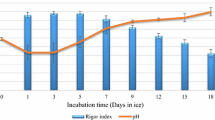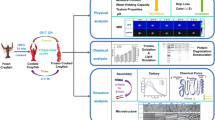Abstract
To elucidate the structural changes in pink (P), white (W), and red (R) muscles during storage in ice, we measured the breaking strength and changes in pericellular connective tissues of cultured carp. The breaking strength just after killing was highest in R muscle (1.00 ± 0.20 N), lowest in W muscle (0.37 ± 0.07 N), and intermediate (0.84 ± 0.12 N) in P muscle. During the storage period, the breaking strength decreased first in R muscle, then in P muscle, followed by W muscle. The diameter of muscle fibers was greater in W muscle (113 ± 15 μm) than in P muscle (72 ± 3 μm) and R muscle (48 ± 2 μm). Destruction of the honeycomb structure of the pericellular connective tissue occurred most rapidly in W muscle and most slowly in R muscle. These results suggest that the interposing of P muscle fibers in the dorsal ordinary muscle contributes to the acceleration of post-mortem tenderization in fish.



Similar content being viewed by others
References
Okazaki E (2012) Sensory evaluation of seafood. Jpn Soc Refrig Air Cond Eng 87:27–34 (in Japanese)
Toyohara H, Shimizu Y (1988) Relation of fish body and the texture of the muscle. Nippon Suisan Gakkaishi 54:1795–1798 (in Japanese with English abstract)
Oka H, Ohno K, Ninomiya J (1990) Changes in texture during cold different storage of cultured yellowtail meat prepared by killing methods. Nippon Suisan Gakkaishi 56:1673–1678 (in Japanese with English abstract)
Ando M, Toyohara H, Shimizu Y, Sakaguchi M (1991) Post-mortem tenderization of fish muscle proceeds independently of resolution of rigor mortis. Nippon Suisan Gakkaishi 57:1165–1169
Ando M, Toyohara H, Sakaguchi M (1992) Post-mortem tenderization of rainbow trout muscle caused by the disintegration of collagen fibers in the pericellular connective tissue. Nippon Suisan Gakkaishi 58:567–570
Ando M, Toyohara H, Sakaguchi M (1992) Three-dimensional structure of collagen fibrillar network of pericellular connective tissue in association with firmness of fish muscle. Nippon Suisan Gakkaishi 58:1361–1364
Hatae K, Tobimatsu A, Takeyama M, Matsumoto J (1986) Contribution of the connective tissue on the texture difference of various fish species. Nippon Suisan Gakkaishi 52:2001–2007 (in Japanese with English abstract)
Tachibana K, Suzuki H, Yagi M, Mishima S, Hara K, Tsuchimoto M (2001) Limitted degradation of α-actinin in the ordinary muscle of cultured red sea bream during storage in ice. Nippon Suisan Gakkaishi 67:723–727 (in Japanese with English abstract)
Tsuchiya H, Kita S, Seki N (1992) Postmortem changes in α-actinin and connectin in carp and rainbow trout muscles. Nippon Suisan Gakkaishi 58:793–798
Tachibana K, Mishima T, Tsuchimoto M (1993) Changes of ultrastructure of cytochemical Mg2+ ATPase activity in ordinary muscle of cultured and wild red sea bream during storage in ice. Nippon Suisan Gakkaishi 59:721–727 (in Japanese with English abstract)
Kumano Y, Seki N (1993) Changes in α-connectin content during storage of iced, frozen, and thawed fish muscles. Nippon Suisan Gakkaishi 59:559–564
Ando M, Toyohara H, Shimizu Y, Sakaguchi M (1991) Post-mortem tenderization of rainbow trout (Oncorhyncus mykiss) muscle caused by gradual disintegration of the extracellular matrix structure. J Sci Food Agric 55:589–597
Ando M, Toyohara H, Shimizu Y, Sakaguchi M (1993) Post-mortem tenderization of fish muscle due to weakening of pericellular connective tissue. Nippon Suisan Gakkaishi 59:1073–1076
Hallet IC, Bremner HA (1986) Degradation in muscle fibre-connective tissue junctions in the spotted trevalla (Seriolella punctata) examined by scanning electron microscopy. J Sci Food Agric 37:1011–1018
Ito K, Toyohara H, Ando M, Sakaguchi M (1992) Disintegration of the pericellular connective tissue of ayu muscle in the spawning season relevant to softening. Nippon Suisan Gakkaishi 58:1553
Ando M, Yoshimoto Y, Inabu K, Nakagawa T, Makinodan Y (1995) Post-mortem change of three-dimensional structure of collagen fibrillar network in fish muscle pericellular connective tissue corresponding to post-mortem tenderization. Fish Sci 61:327–330
Hallet IC, Bremner HA (1988) Fine structure of the myocommata-muscle fiber junction in hoki (Macruronus novaezelandiae). J Sci Food Agric 44:245–261
Ando M, Joka M, Mochizuki S, Satoh K, Tsukamasa Y, Makinodan Y (2001) Influence of death struggle on the structural changes in chub mackerel muscle during chilled storage. Fish Sci 67:744–751
Johnston IA (1981) Structure and function of fish muscles. Symp Zool Soc Lond 48:71–113
Liang J, Tsuchimoto M, Xiao N, Kawaguchi Y, Ono K, Hamada Y, Taniyama S, Tachibana K (2011) Ultrastructural changes of three muscle types of cultured carp (Cyprinus carpio) during storage in ice. J Food Chem Saf 18:168–173 (in Japanese with English abstract)
Jabarsyah A, Tsuchimoto M, Kozuru Y, Miyake T, Misima T, Yada O, Tachibana K (1999) Discrimination of muscle fiber types in ordinary muscle by actomyosin ATPase activity and its comparison among various fishes and muscle parts. Fish Sci 65:291–299
Yada O, Tsuchimoto M, Wang Q, Apablaza PAG, Kozuru Y, Jabarsyah A, Tachibana K (2000) Differences of muscle fiber type and temporal change of K-value among parts toward depth of dorsal muscle in carp (cultured). Fish Sci 66:147–152
Jabarsyah A, Tsuchimoto M, Yada O, Kozuru Y, Miyake T, Misima T, Wang Q, Tachibana K (2000) Comparison of biochemical and physiological characteristics among white, pink, and red muscle fibers in carp (cultured). Fish Sci 66:586–593
Ohtani O (1987) Three-dimensional organization of the connective tissue fibers of the human pancreas: a scanning electron microscopic study of NaOH treated-tissues. Arch Histol Jpn 50:557–566
Ishikawa H (2011) Fix and dehydration. In: The Japanese society of microscopy, Kanto branch (ed) New-scanning electron microscope. Kyoritsu Shuppan, Tokyo, pp 228–231 (in Japanese)
Murakami T (1974) A revised tannin-osmium method for non-coated scanning electron microscope specimens. Arch Histol Jpn 36:189–193
Misima T, Fujii J, Tachibana K, Tsuchimoto M (1995) Influence of contracture on breaking strength in carp muscle. Fish Sci 61:209–213
Sato K, Ohashi C, Ohtsuki K, Kawabata M (1991) Type collagen in trout (Salmo gairdneri) muscle and its solubility change during chilled storage of muscle. J Agric Food Chem 39:1222–1225
Saito M, Kunisaki N, Urano N, Kimura S (2000) Characterization of cDNA clone encoding the matrix metalloproteinase 2 from rainbow trout fibroblast. Fish Sci 66:334–342
Sato K, Yoshinaka R, Sato M, Shimizu Y (1986) Collagen content in the muscle of fishes in association with their swimming movement and meat texture. Nippon Suisan Gakkaishi 52:1595–1600
Toyohara H, Ando M, Shimizu Y (1990) Appearance of a 38,000-dalton component possibly associated with the post-mortem tenderization of rainbow trout muscle. Agric Biol Chem 54:1575–1576
Abe H (1991) II. Factors influencing rigor mortis, 6. Factors influencing rigor mortis. In: Yamanaka H (ed) Rigor mortis in fish. Koseisha-Koseikaku, Tokyo, pp 62–73 (in Japanese)
Iwamoto M (1991) II. Factors influencing rigor mortis, 7. Effects of death and storage temperature. In: Yamanaka H (ed) Rigor mortis in fish. Koseisha-Koseikaku, Tokyo, pp 62–73 (in Japanese)
Yada O, Tsuchimoto M, Jabarsyah A, Wang Q, Apablaza PAG, Tachibana K (2001) Influence of interposition of pink muscle fiber into dorsal ordinary muscle on increasing rate of K-value in various fish species. Fish Sci 67:675–681
Takahashi K, Fukuzawa T, Yasui T (1967) Formation of myofibrillar fragments and reversible contraction of sarcomeres in chicken pectoral muscle. J Food Sci 32:409–413
Hibiya T (1976) Muscle tissue. In: Japanese society of fisheries science (ed) The white muscle and red muscle, properties of fish muscle. Koseisha-Koseikaku, Tokyo, pp 24–25 (in Japanese)
Warrier SBK, Ninjoor V, Swant PL, Kumta US (1972) Lysosomal enzymes in drip and muscle of Harpodon nehereus. Indian J Biochem Biophys 9:207–209
Brid JWG, Berg T, Milanesi A, Stauber WT (1969) Lysosomal enzymes in aquatic species-I. Distribution and particle properties of muscle lysosome of the goldfish. Comp Biochem Physiol 30:457–467
Ueno R, Liston J, Horiguchi Y (1986) Studies of lysosomal enzymes in fish muscle tissue-III. Intercellular distribution of enzymes and particle properties of lysosomes in mackerel muscle tissue. Nippon Suisan Gakkaishi 52:895–900
Ueno R, Morishita T, Takahashi T (1981) Intracellular distribution of enzymes and particle properties of lysosomes in carp muscle tissue. Nippon Suisan Gakkaishi 47:207–214 (in Japanese with English abstract)
Acknowledgments
We thank Dr. Satuito Cyril Glenn Perez, Nagasaki University, for reviewing this manuscript.
Author information
Authors and Affiliations
Corresponding author
Rights and permissions
About this article
Cite this article
Liang, J., Miyazaki, R., Zhao, X. et al. Changes in the pericellular connective tissue and breaking strength of the three types of muscles of the cultured carp Cyprinus carpio during storage in ice. Fish Sci 80, 1083–1088 (2014). https://doi.org/10.1007/s12562-014-0769-z
Received:
Accepted:
Published:
Issue Date:
DOI: https://doi.org/10.1007/s12562-014-0769-z




